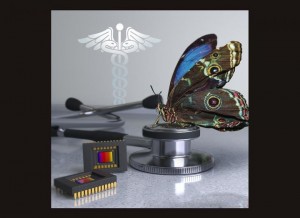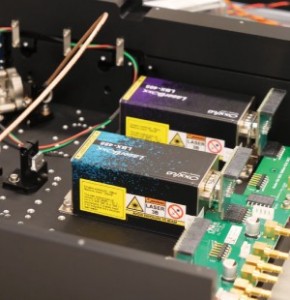
Researchers at the University of Illinois at Urbana-Champaign (UIUC) have created a new camera that mimics the intricate visual system of the morpho butterfly. The nanostructures in the butterfly’s eyes can sense multispectral information — near-infrared and color — simultaneously. Accordingly, the new bio-inspired camera provides surgeons with both a traditional color image as well as a near-infrared image that makes fluorescently labeled cancerous cells visible even under bright surgical lighting.
Inspired by the inventiveness of nature
“The morpho butterfly uses various nanostructures in their body for both sensing and signaling,” explains Viktor Gruev, UIUC associate professor of electrical and computer engineering, who led the research team. The iridescent blue color of the butterfly’s wings comes from photonic, tree-like structures. According to the professor, similar nanostructures in their eyes are excellent color filters with performance surpassing polymer-based color filters typically used in cameras. “So we mimicked the butterfly’s visual system by fabricating optical photonic structures on top a camera that resemble the optical filters in the morpho butterfly,” Gruev reports. “These highly optimized nanostructures enabled us to create a camera with higher sensitivity to detect fluorescence than state-of-the-art cameras.”
The researchers then used this camera to detect fluorescence signals from drugs used in cancer surgery. “We were able to identify the location of sentinel lymph nodes in patients with breast cancer under surgical light conditions,” he reports, adding that in the study, the camera was seamlessly integrated in the surgical workflow and provided key information in time-critical moments during the cancer surgery.
A significant enhancement to the painstaking work of surgeons
“We are able to detect near-infrared fluorescence information under surgical light conditions with 1000 [times] higher sensitivity than FDA-approved instruments,” Gruev reveals. “Furthermore, we have six-fold higher accuracy in presenting the location of the cancer tissue than FDA-approved instruments.”
The instrument, according to its inventors, is also very compact and inexpensive, which could be helpful with integration in the surgical workflow in hospitals.
Significance of the camera’s ability to simultaneously provide NIR and color information
“The human eye is blind to the NIR spectrum, so we need sensors that can record this information,” Gruev says. “This information has to be correctly co-registered with the color image to show where the tumor is with respect to the anatomical features.” He adds that the near-infrared spectrum is also very interesting for biomedical imaging because it enables deeper tissue imaging and gives excellent signal to background information.
Impact on the design of future cameras
“This is paradigm-shifting technology for image-guided surgery,” Gruev stresses. “We show that we solve critically important clinical problems: correctly co-registering NIR with color information and enabling imaging of weak fluorescence under surgical light conditions.” The expert explains that without solving these tasks, surgeons run the risk of incomplete cancer removal and of damaging healthy tissue. “Future imaging systems for image-guided surgery will rely on this design paradigm,” he projects.
Next step
As a next step in the process of optimizing the bio-inspired camera and eventually making it available to surgeons, Gruev says he and his colleagues want to further improve the imaging system in terms of information it can record in the operating room and providing this critical information, such as location of cancerous tissue, in time-critical settings. “We are focusing on commercializing the current technology,” he concludes.
The research is detailed in the Optica paper “A bio-inspired imager improves sensitivity for near-infrared fluorescence image-guided surgery.”
Written by Sandra Henderson, Research Editor, Novus Light Technologies Today























 Back to Features
Back to Features



























